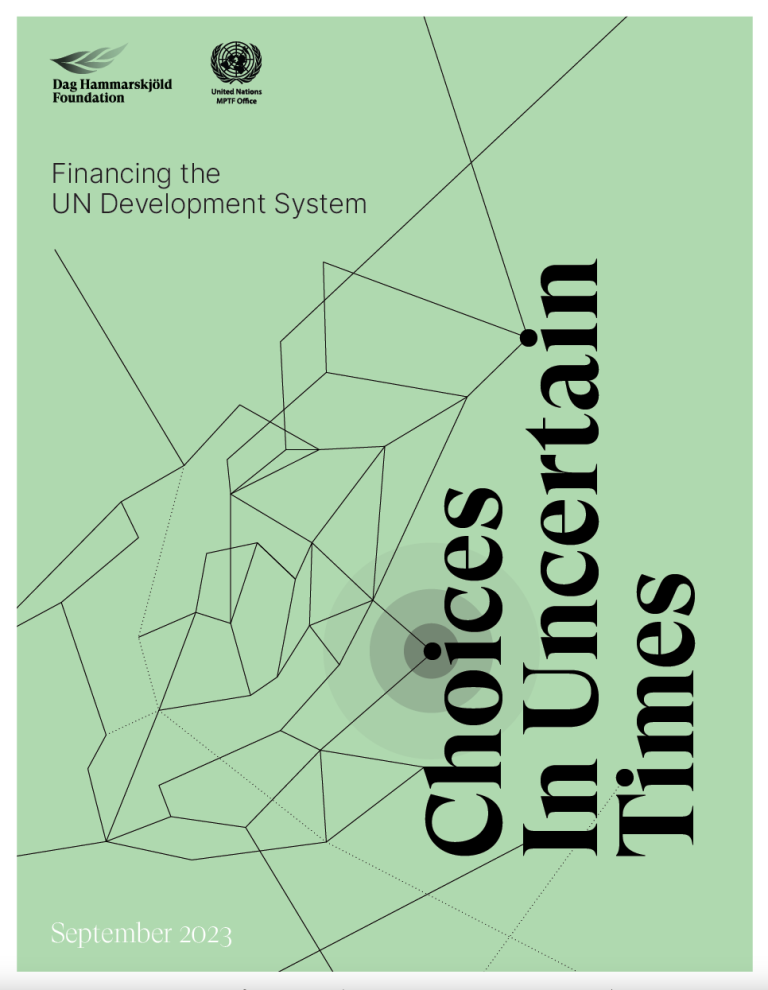Introduction
The Sustainable Development Goals (SDGs) were agreed upon unanimously in 2015 by the United Nations General Assembly and are due to be achieved by 2030. However, progress has been too slow and incomplete, with recent events such as the COVID-19 pandemic and the global economic crisis caused by the Ukraine war further setting back progress, especially in regard to poverty and food security targets. Although thecommon response to this shortfall has been to argue for more international development and climate finance, for policy and institutional reform aimed at monitoring progress towards the SDGs and climate goals, and for innovative solutions, this article argues that such efforts are not enough.
This article therefore proposes a ‘scaling approach’ to investment programme/project design and implementation, whereby the programme/project supports a scaling pathway towards a long-term vision of development impact explicitly linked to the appropriate SDG and climate targets. This approach addresses the failings of the current one-off programme/project approach, which promotes the piloting of innovative features without a clear vision of whether and how successful interventions can be sustainably replicated and scaled (‘pilots to nowhere’).
Increasing aggregate financial resources devoted to achieving the SDGs and climate goals
A common response to the challenge of achieving the SDGs by 2030 is to increase the aggregate financial resources devoted to their attainment. However, while research on the effectiveness of aid has shown that individual projects and programmes may have positive impacts, efforts to measure the impact of aid on an aggregate, country-wide basis have been much more ambiguous.3 This is due to poor institutions and policies, instability and conflict in recipient countries, increasingly fragmented donor programmes, declining project size and the one-off nature of donor-funded projects.
Climate finance faces even greater challenges than traditional development assistance, such as those related to predictability of disbursements, affordability and concessionality of funding, provider proliferation and project fragmentation, and the degree to which climate-related interventions are evaluated.5 Therefore, while increased finance is an essential component of any strategy to improve the chances of attaining the SDGs by 2030, it is not enough. Rather, it needs to be complemented by significant changes to domestic institutions and policies, and in how projects and programmes are funded and implemented. The focus should thus be on mobilising funding to support organisations and programmes that systematically pursue scaling pathways towards the achievement of global goals and targets.
Top-down mapping and monitoring of SDG implementation and climate action at national and local levels
The UN-led effort to map global targets into national targets and monitor progress at a country level involves the preparation of voluntary national reviews (VNRs) and nationally determined contributions (NDCs) for climate targets. VNRs facilitate the sharing of experiences, the strengthening of policies and institutions, and the mobilising of multi-stakeholder support for implementing the SDGs.6 Since 2016, 306 VNRs have been conducted, with some countries detailing policy changes and specific programmes/projects aligned with the SDGs. However, the focus on replicability or scalability of projects supporting SDGs is limited in VNRs, which is not surprising since the preparation handbook does not provide specific guidance.
NDCs involve setting and monitoring national climate goals and are regularly reviewed by the UN Framework Convention on Climate Change. Generally, however, systematic links between specific climate programmes and NDC commitments are lacking.8 Overall, VNRs and NDCs represent a top-down approach to support the SDGs and climate goals, with little consideration of replicating and scaling successful programmes. Nevertheless, they offer potential benefits for a bottom-up scaling approach by providing national targets, supporting policy changes, and monitoring cumulative impact at the national level.
Local voluntary reviews (VLRs) for the SDGs are similar to VNRs but focus on the provincial and city levels. Since 2016, 97 VLRs have been completed, including 39 for developing countries. VLRs map regional/city plans and priorities to the SDGs, and track progress over time. Some VLRs highlight particular programmes/projects, occasionally emphasising replication and scaling towards specific goals.
In terms of climate action, regional and local authorities can contribute to achieving national climate goals such as NDCs, while efforts to develop regionally and locally determined contributions (RLDCs) are ongoing. Although VLRs (and the potential RLDCs) tend to adopt a more bottom-up approach than VNRs and NDCs, there is no indication that they systematically and effectively link specific local programmes/projects to local- or nationalscale targets within the context of the SDGs or Paris Agreement climate goals.
In sum, national and local mapping, the monitoring of SDG and climate targets represents a helpful tool in assessing progress as well as motivating action, but is not designed to systematically orient investment programmes/projects towards their achievement.
Innovation for the achievement of the SDGs and climate goals
The approval of the SDGs and Paris Agreement climate targets has led to a surge in calls for innovation to achieve the various goals. Numerous initiatives, such as innovation marketplaces, labs, accelerators and challenge funds, have been established.
However, innovation alone cannot deliver the sustainable impact at scale needed to achieve the SDGs. Funders have mostly emphasised innovation over replication and scaling,10 often focusing on the early phases of scaling pathways, with insufficient financial resources devoted to scaling effectively.
The Brookings Institution and Rockefeller Foundation’s 17 Rooms initiative promotes innovative ideas across the full range of SDGs and in some cases supports a scaling approach.12 As a general rule, though, one should avoid ‘magical thinking’ that just because an idea has been piloted with positive results, someone will pick it up and run with it. Instead, it is essential that a systematic approach is pursued to ensure scaling actually happens, with an iterative process of innovation, learning and scaling employed where appropriate (Figure 1).
Figure 1: Innovation, learning and scaling interact to achieve sustainable impact at scale

Lack of attention to the SDGs and climate targets at a programme/project level
The development effectiveness and evaluation literature, the work of the Scaling Community of Practice over the last eight years, and the evidence summarised above demonstrate that there remains a yawning gap between high-level declarations of support for the SDGs and climate targets and the development programmes/projects being implemented on the ground.13 These projects rarely focus on linking their goals, design, implementation and evaluation systematically and effectively with long-term development goals such as the Millenium Development Goals (MDGs) and SDGs.
Two main reasons contribute to the gap between SDGs and bottom-up development programmes/projects. First, as noted above, there is generally a preoccupation with innovation as the preferred response to development and climate change challenges, with the scaling of successful innovations often left to chance. Second, externally funded programmes/projects focus on getting started, funded and achieving promised impacts, but frequently lack a longer-term focus on sustainable scaling towards the SDGs.
To close the gap between the SDGs and development programmes/projects, a systematic approach to scaling the impact of proven interventions towards SDG achievement is needed. Existing top-down approaches, such as focusing on financing and tracking progress, are important but insufficient. In addition, the design and implementation of development and climate programmes/projects must be systematically calibrated to focus on achieving long-term goals and targets.
Key elements of a scaling approach to support SDG achievement
Scaling’ refers to a systematic process leading to sustainable impact, affecting a large and increasing proportion of those experiencing the relevant need.14 A six-step scaling approach can be adopted to connect development programmes/projects with the SDGs:
1. define the development problem and long-term vision of scale to be attained and link it to the appropriate SDG target(s). Scaling often takes 10–15 years or more;
2. explore the role of an intervention (innovation, project, programme) by assessing how it will address the problem and support a scaling pathway, and consider alternative solutions;
3. assess the intervention’s scalability in light of the enabling conditions for scaling, such as, political support, policy reform and available resources;
4. develop partnerships to support the achievement of scale by assuring the necessary technical and institutional capacity, funding and political buy-in, as well as facilitating hand-off at project end;
5. pay attention to sequencing, including proper piloting, continuity and effective transitions, combining replication (horizontal scaling) with policy/institutional reform (vertical scaling), and adopting the appropriate sequencing of financing instruments; and
6. monitor and evaluate progress along the pathway and adapt as needed, ensuring a smooth transition from one project to the next and maintaining scaled-up impact.
Figure 2 visualises the scaling pathway as a sequence of projects, thereby demonstrating important aspects of the scaling process presented above, including: the need for a scaling target linked to one or more SDGs and a notional pathway to reach it; the importance of ensuring each project builds a platform of enabling conditions on which the next project can build; the need to ensure a smooth transition from one project to the next; and the critical link between sustainability and scaling – without sustainability, scaled-up impact cannot be maintained (see the red dotted arrows), while sustainability without scaling will not achieve the target.
An example of the practical application of the above scaling approach can be found in a 2017 scaling review of four UN Development Programme (UNDP) country programmes in Bosnia and Herzegovina, Egypt, Moldova and Tajikistan, which analysed 29 projects across various sectors.
The assessment revealed that UNDP projects performed well in identifying development problems and scaling pathways, addressing both the horizontal and vertical dimensions of scaling, and considering political, policy and social factors. However, they did less well in identifying scale targets and linking them to SDGs, assessing scalability (including such aspects as community demand, champions and incentives, and fiscal constraints), pursuing partnerships, following up on pilots and considering sustainability. The study recommended that UNDP strengthen its operational approach by systematically focusing on scaling, especially those dimensions currently not effectively considered, and linking its programmes/ projects more directly to specific SDGs.
Figure 2: The scaling pathway as a sequence of projects

Conclusion
A comprehensive 2007 report on implementation of the MDGs – the predecessors of the SDGs – noted that progress at the halfway mark fell short of what was required to reach the targets by 2015.16 As such, the report presented a wealth of recommendations, including a more systematic focus on scaling up the impact of development interventions. Too little has been done since then to heed this advice, although we now have a much better understanding of what it takes to scale up successfully.
We have learned, for example, that good development programme design and implementation already incorporate elements of a scaling strategy, and that linking development programmes to the SDGs through scaling is not overly complicated.
However, we have also learned that a change in mindset is required for all actors involved. Development institutions should systematically internalise the scaling agenda and its link to the SDGs and climate targets as part of their programme/project design, implementation and evaluation.
The Scaling Community of Practice is supporting this institutional internalisation process by developing generally applicable scaling principles and lessons,17, exploring how government institutions can institutionalise the scaling of innovative ideas brought in from the outside18, and undertaking research on mainstreaming scaling in funder organisations.
The overarching conclusion is that systematic scaling of proven development and climate interventions in support of the SDGs and climate targets must complement other efforts, including financial resource mobilisation, progress monitoring and innovation.
This is an article originally published in the Dag Hammarskjöld Foundation’s “Financing the UN Development System: Choices in Uncertain Times 2023” report.





